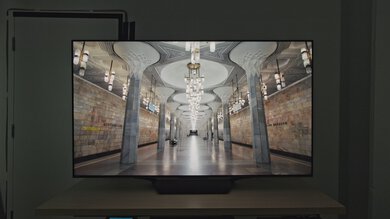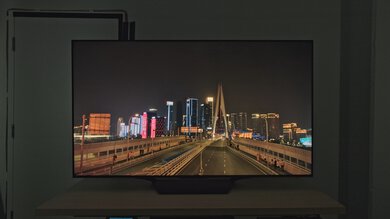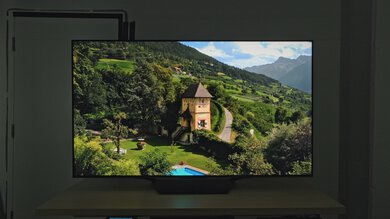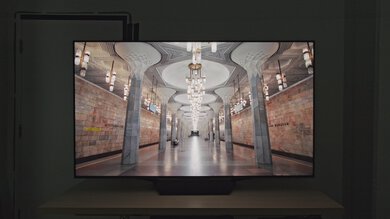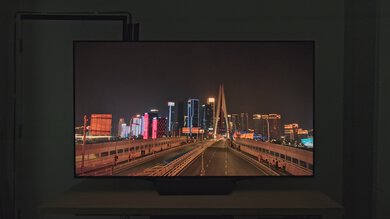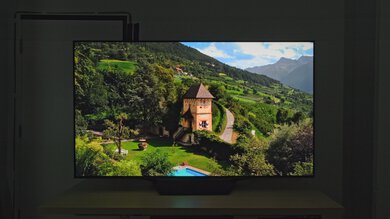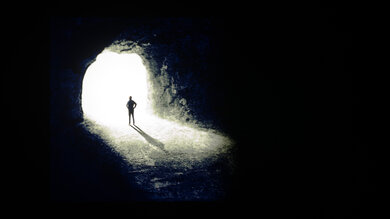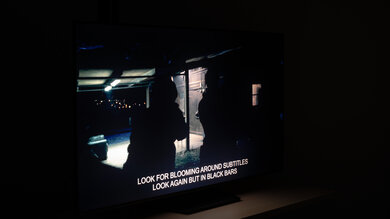The Hisense U7N is a lower mid-range TV released in 2024 and replaces the Hisense U7K. It's part of Hisense's popular ULED lineup, sitting between the budget-friendly Hisense U6/U6N and the mid-range Hisense U8/U8N. The TV is loaded with modern features like local dimming, HDMI 2.1 bandwidth, 4k @ 144Hz, VRR support, ATSC 3.0, and Dolby Vision. It promises higher peak brightness than its predecessor and uses Hisense's new Hi-View Engine PRO chipset, which is meant to optimize the display to provide a better overall image. The TV uses the Google TV interface, which offers smart features like voice control, and it's loaded with apps. The TV has a built-in 40W 2.1 channel speaker system. We bought and tested the 65-inch model, but it's available in four sizes total: 55-inch, 65-inch, 75-inch, and 85-inch.
Our Verdict
The Hisense U7N is a good TV for mixed usage. It looks good in a dark room thanks to its decent black levels, and content is bright no matter the context thanks to its impressive peak brightness, especially in SDR. It does struggle a bit with direct reflections, but it makes up for it by sustaining its black levels and colors when watched in bright rooms. Its image processing is quite good, as it cleans up low-bitrate and low-resolution content very well, all while respecting the content creator's intent when watching HDR movies. It's also a solid choice for gaming due to its low input lag, VRR feature, and supported resolutions, although it performs best at faster refresh rates. Unfortunately for sports fans, the TV's viewing angle is not quite good enough to offer a pleasant viewing experience from the sides, although it's good enough for smaller gatherings.
Good color volume in HDR and SDR.
Very good HDR brightness, so bright highlights stand out.
Solid image processing when dealing with low-bitrate and low-resolution content.
Image degrades somewhat when viewed from extreme angles.
Mediocre SDR pre-calibration accuracy.
Visible glare when placed directly opposite bright lights or windows.
The Hisense U7N is good for a home theater. It has good brightness in HDR, decent black levels, and good HDR color volume, so the TV is bright, colorful, and highlights pop. Its HDR color accuracy is also decent, but purists are likely to want to calibrate the TV for the best possible viewing experience; everyone else will be satisfied. Another strength of this TV is its image processing, which is quite good. It removes a lot of macro-blocking from low-bitrate movies, and it upscales SD content well. Its HDR brightness is accurate, so it follows the content creator's intent well. It does have some banding in HDR gradients, but it's not excessive. Finally, its relatively slow response time means that the TV doesn't have a lot of stutter.
Good color volume in HDR and SDR.
Very good HDR brightness, so bright highlights stand out.
Solid image processing when dealing with low-bitrate and low-resolution content.
Follows the content creator's intent well.
Limited stutter when watching movies.
- Unremarkable SDR pre-calibration accuracy.
The Hisense U7N is great to watch SDR content in a brighter room. It's extremely bright in SDR, with good color volume, so your content looks bright and colorful enough. Unfortunately its handling of direct reflections is only mediocre, so avoid placing any lights or windows directly opposite it for the best experience. At least its colors and black levels don't suffer much in bright environments, so ultimately, you still get a very good viewing experience.
Good color volume in HDR and SDR.
Easily bright enough in SDR for well-lit rooms.
Mediocre SDR pre-calibration accuracy.
Visible glare when placed directly opposite bright lights or windows.
The Hisense U7N is very good for watching sports. It's extremely bright in SDR, with good color volume, so sports look bright and colorful. However, it's not a very accurate TV in SDR, so your favorite team's jerseys look a bit off from what they should be, although not by much. The TV's image processing capabilities are well-suited for sports, as it upscales low-resolution feeds well, and it impressively cleans up any macro-blocking when streaming sports. Unfortunately, the TV's handling of direct reflections is only mediocre, so avoid placing any lights directly opposite it. Its response time is also on the lower side, leading to some motion blur in fast-moving sports. Also, avoid having any friends at extreme angles from the TV, as the TV's viewing angle is not quite good enough to offer a pleasant viewing experience from the sides, although it's good enough for small gatherings.
Good color volume in HDR and SDR.
Easily bright enough in SDR for well-lit rooms.
Solid image processing when dealing with low-bitrate and low-resolution content.
Image degrades somewhat when viewed from extreme angles.
Mediocre SDR pre-calibration accuracy.
Visible glare when placed directly opposite bright lights or windows.
The Hisense U7N is good for playing video games with modern gaming PCs and consoles thanks to its HDMI 2.1 bandwidth, up to 4k @ 144Hz, and VRR support, although there's an issue that affects the TV's response time when it hovers around 100Hz when using VRR. It has low input lag, so you get a snappy gaming experience, especially at 120Hz. The TV is bright in HDR and especially in SDR, and its colors are good, so your games look colorful enough. Its black levels are decent enough that blacks stay somewhat deep and punchy when bright highlights are on the screen. For the best experience, avoid playing at 60Hz, as the TV's response time is noticeably slower there, leading to some black smearing.
Low input lag, especially at 120Hz and above.
Good color volume in HDR and SDR.
- HDMI 2.1 bandwidth, up to 4k @ 144Hz, and VRR support.
- Unremarkable SDR pre-calibration accuracy.
The TV's response time isn't quite good enough for a motion-blur free experience, especially at 60Hz.
VRR issues around 100Hz.
The Hisense U7N's brightness performance is impressive, even more so in SDR, where the TV is extremely bright. It's no slouch in HDR content, however, and highlights pop no matter what you're watching.
Very good HDR brightness, so bright highlights stand out.
Easily bright enough in SDR for well-lit rooms.
The Hisense U7N has satisfactory black levels. It has decent contrast, with blacks that stay somewhat deep and punchy when bright highlights are on screen. Its lighting zone precision holds the TV back a bit, as there's some noticeable blooming around highlights, which also impacts the TV's black uniformity. Still, overall, it's enough for a pleasant viewing experience in darker rooms.
The Hisense U7N has decent color performance overall. It has good color volume in HDR and SDR, so it's colorful enough no matter the content. Unfortunately, its SDR pre-calibration accuracy is only mediocre. It's a bit more accurate in HDR, but, overall purists will likely want to have their TV calibrated for the best viewing experience.
Good color volume in HDR and SDR.
Mediocre SDR pre-calibration accuracy.
Note: We're in the process of improving our tests related to image processing, but this score should give you a general idea of how a TV performs overall with its image processing capabilities.
The Hisense U7N's image processing is good overall. It cleans up macro-blocking from low-bitrate content quite well, and it also does a good job when upscaling low-resolution content, such as from DVDs. Its PQ EOTF tracking is very good, so it mostly follows the content creator's intent when it comes to HDR brightness. There's some banding in HDR gradients, but it's not excessive.
Solid image processing when dealing with low-bitrate and low-resolution content.
Follows the content creator's intent well.
The Hisense U7N is responsive in Game Mode, with its low input lag, support for a variety of VRR modes, and a large amount of supported resolutions. Unfortunately, its response time isn't quite fast enough to provide a truly motion-blur free gaming experience, with some noticeable black smearing at 60Hz. The TV's VRR feature is also uneven, as the TV's response time changes depending on whether its refresh rate is below or above 100Hz, which adds to the TV's response time issues.
Low input lag, especially at 120Hz and above.
- HDMI 2.1 bandwidth, up to 4k @ 144Hz, and VRR support.
The TV's response time isn't quite good enough for a motion-blur free experience, especially at 60Hz.
VRR issues around 100Hz.
We're in the process of fixing the way we evaluate a TV's overall motion handling. This section is currently broken, and the score isn't indicative of how well a TV handles motion overall.
Performance Usages
Changelog
-
Updated Jun 13, 2025:
We mentioned the newly reviewed Hisense U75QG in the HDR Brightness section of this review.
- Updated May 08, 2025: Converted to Test Bench 2.0.1. We did this to fix an issue with our scoring in the Supported Resolutions section, since TVs with a refresh rate higher than 144Hz were being penalized for not supporting 144Hz.
-
Updated Apr 14, 2025:
We mentioned the newly reviewed TCL QM7K in the SDR Pre-Calibration Color Accuracy section of this review.
-
Updated Mar 31, 2025:
We mentioned the newly reviewed Amazon Fire TV Omni Mini-LED Series in the Contrast section of this review.
Check Price
Differences Between Sizes And Variants
We bought and tested the 65-inch Hisense U7N, and the results are also valid for the 55-inch and 85-inch models. The 75-inch model uses an ADS Pro panel, so it performs a bit differently than the other sizes, with worse contrast but a better viewing angle. The 55-inch model uses HDMI 3 as its eARC port in regions outside of North America, so you do lose a high-bandwidth port on that size if you plug in a soundbar.
In Canada, the TV is known as the Hisense U78N and performs the same. There are similarly-named international models, like the U7NAU in Australia, but these models perform differently from the North American U7N, so our results aren't valid for them. Costco has a 65-inch and 75-inch variant of the TV known as the Hisense U75N. These variants perform the same but come with an extended warranty and a gift card for Google Play.
| Size | US Model | Local Dimming Zones | Panel Type | Costco Variant |
|---|---|---|---|---|
| 55" | Hisense 55U7N | 240 | VA | - |
| 65" | Hisense 65U7N | 384 | VA | 65U75N |
| 75" | Hisense 75U7N | 512 | ADS Pro | 75U75N |
| 85" | Hisense 85U7N | 768 | VA | - |
Our unit was manufactured in February 2024.
Popular TV Comparisons
The Hisense U7N is easily one of the best lower mid-range TVs on the market, and it's affordable compared to similar offerings from major brands like Sony, LG, and Samsung. It's very similar to its predecessor, the Hisense U7K, but it's even brighter overall and has better contrast. It even holds its own against higher-tier TVs like the Samsung QN85D/QN85DD QLED, with similar overall picture quality for less money. If you need a TV packed with modern features but don't want to spend more on the Hisense U8N, it's one of the best options available. Still, ouside of the Hisense's superior image processing and accuracy, the similar TCL QM7/QM751G QLED is better overall, as it's brighter, more colorful, and has much better black levels.
For more options, check out our recommendations for the best TVs for bright rooms, the best 65-inch TVs, and the best TVs for gaming.
The Hisense U7N is mostly better than the TCL QM6K. The Hisense is brighter and more colorful overall, alongside having better image processing, delivering a generally more impactful viewing experience, even with the TCL's better black levels. The TCL does have some advantages, as it's more accurate, and has faster pixel transitions, alongside more gaming features than the Hisense.
The TCL QM7K is mostly better than the Hisense U7N. While the Hisense is brighter overall, the TCL's black levels are much better due to its vastly superior contrast ratio, giving it the more impactful image overall. Gamers will also appreciate the QM7K's 1080p @ 288Hz support, alongside noticeably faster pixel transitions than the Hisense.
The Hisense U7N and the TCL QM751G are closely matched, with the TCL having the edge. While the Hisense has far better reflection handling and is the most accurate of the two TVs in SDR and HDR, the TCL is the punchier option due to its deeper black levels, better color volume, and slightly higher peak brightness.
The Hisense U7K and the Hisense U7N are similar, but the U7N is a bit better in several ways. The U7N is brighter overall, so it handles more glare in a bright room when watching SDR content, and highlights in HDR content stand out more. The U7N has better contrast thanks to its more effective local dimming feature, so blacks are deeper on it. The U7N also has much better PQ EOTF tracking, so it's more accurate with HDR content. On the other hand, the U7K has much better pre-calibration SDR accuracy, so it's better for those who care most about color accuracy without needing calibration.

We buy and test dozens of TVs yearly, taking an objective, data-driven approach to deliver results you can trust. Our testing process is complex, with hundreds of individual tests that take over a week to complete. Most of our tests are done with specially designed test patterns that mimic real content, but we also use the same sources you have at home to ensure our results match the real-world experience. We use two main tools for our testing: a Colorimetry Research CR-100 colorimeter and a CR-250 spectroradiometer.
Test Results

The Hisense U7 has very good HDR brightness, so highlights really stand out during darker scenes. Combined with its amazing contrast, this TV provides an impactful HDR viewing experience. If you'd prefer a slightly brighter TV, check out the TCL QM7/QM751G QLED instead. The U7N's successor, the Hisense U75QG, is noticeably brighter.
These measurements are after calibrating the HDR white point with the following settings:
- HDR Picture Mode: Filmmaker Mode
- Local Dimming: High
- Peak Brightness: High
- Brightness: 100
- Contrast: 50
- Black Level: 0
- Dark Detail: Off
- Gamma: ST2084
- Active Contrast: Off
- Dynamic Tone Mapping: Off
- Color Temperature: Warm 1
Results with Dynamic Tone Mapping set to 'On':
- Hallway Lights: 611 cd/m²
- Yellow Skyscraper: 544 cd/m²
- Landscape Pool: 431 cd/m²
The Hisense U7 is slightly brighter in PC/Game Mode, but it's not noticeable.
These measurements are after calibrating the HDR white point with the following settings:
- HDR Picture Mode: HDR Game
- Local Dimming: High
- Peak Brightness: High
- Brightness: 100
- Contrast: 50
- Black Level: 0
- Dark Detail: Off
- Gamma: ST2084
- Active Contrast: Off
- Dynamic Tone Mapping: Off
- Color Temperature: Warm 1
Results with Dynamic Tone Mapping set to 'On':
- Hallway Lights: 591 cd/m²
- Yellow Skyscraper: 471 cd/m²
- Landscape Pool: 411 cd/m²
The Hisense U7 has amazing SDR brightness, and it overcomes glare in very bright rooms.
These measurements are after calibration with the following settings:
- Picture Mode: Theater Night
- Local Dimming: High
- Peak Brightness: High
- Brightness: 100
- Gamma: 2.2
- Color Temperature: Warm 1
- Active Contrast: Off
The Hisense U75 has decent contrast. Its effective local dimming feature provides deep blacks in a dark room, and they mostly stay deep when highlights are also on screen. If you want a similar TV with even better contrast, check out the Roku Pro Series 2024 or Amazon Fire TV Omni Mini-LED Series instead.
The TV has good overall lighting zone transitions, but it struggles with very fast-moving content. There's noticeable haloing, and the leading edge of bright, quick-moving objects is visibly dimmer.
The TV has good SDR color volume. It has impressive coverage of the commonly used DCI-P3 color space, although it can't quite fully display bright greens, yellows, and oranges. The TV has okay coverage of the wider BT.2020 color space, but its color volume isn't quite good enough to fully display most colors, with the exception of some magentas.
| Volume ΔE³ | DCI-P3 Coverage |
BT.2020 Coverage |
|---|---|---|
| L10 | 90.64% | 68.56% |
| L20 | 92.28% | 69.17% |
| L30 | 92.56% | 69.62% |
| L40 | 92.24% | 71.35% |
| L50 | 91.72% | 71.42% |
| L60 | 91.03% | 69.03% |
| L70 | 90.74% | 60.33% |
| L80 | 90.21% | 57.61% |
| L90 | 89.87% | 58.68% |
| L100 | 91.58% | 77.03% |
| Total | 91.13% | 65.39% |
The TV has good HDR color volume. Dark saturated colors are displayed well due to the TV's amazing contrast. The TV displays a wide range of colors at high luminance levels, but it does struggle a bit with displaying very bright and saturated magentas and reds.
The Hisense U7 has unremarkable pre-calibration SDR accuracy. Its white balance is poor, with blues very overrepresented in all shades of gray and greens underrepresented in most grays. The color temperature is okay, but it's noticeably cooler than our target of 6,500K. Gamma is close to our target of 2.2, but dark scenes are too bright, and most other scenes are too dark. Its color accuracy is good, but there are inaccuracies with whites, lighter yellows, and lighter cyans. If accuracy matters to you, check out the TCL QM7K instead.
The Hisense U7 has fantastic SDR accuracy after calibration, and the TV is easy to calibrate. Any issues with white balance are gone, and the color temperature and gamma are essentially perfect. Color accuracy is outstanding, with only minor inaccuracies in saturated colors that aren't noticeable to most people.
You can see our full calibration settings.
The Hisense U7 has decent pre-calibration accuracy in HDR, mostly due to its great white balance, although blues are significantly overrepresented in brighter grays, and reds are somewhat overrepresented in mid-grays. This gives the TV a middling color temperature, which is too blue overall. Its color accuracy is satisfactory, although most colors are noticeably off-target, with significant color mapping issues.
The TV's accuracy is very good after calibration. Its white balance is improved, so now blues and reds are only slightly overrepresented in mid-grays. This also makes its color temperature better, although it's still noticeably too cold. Colors are now more accurate, with more of them on target, although many of them still deviate significantly from what they should be.
The TV has very good PQ EOTF tracking. Blacks are slightly too bright, and some shadows and mid-tones are slightly too dark, but the TV closely follows the curve until it reaches its peak brightness. There's a sharp cutoff near the TV's peak brightness, which means the TV prefers hitting the highest peak brightness possible over preserving gradation in bright areas.
The Hisense U75 does a good job at upscaling low-resolution content like DVDs or lower-resolution streams. Details are clear enough, but finer details are hard to make out.
Sharpness processing was calibrated with no over-sharpening for low-resolution content, with the following settings:
- Sharpness: 13
- Super Resolution: On
The TV has satisfactory HDR gradient handling. There's noticeable banding in greens and darker grays, but all other colors have minimal banding.
This TV has low input lag when set to PC/Game Mode, especially at 120Hz and above, which ensures a very responsive gaming experience. The TV's input lag is much higher at 60Hz; while still good, you'll definitely feel it if you're sensitive to it. In 1080p @ 240Hz, the TV's input lag is 4.1 ms, while it is 5.1 ms in 4k @ 144Hz.
The TV supports all common resolutions up to 4k @ 144Hz on two of its four HDMI ports. Unfortunately, 1080p @ 240Hz only works properly with VRR disabled.
The Hisense U75 supports all three VRR formats, so it has great compatibility regardless of the source. Unfortunately, with 1080p @ 240Hz and VRR enabled, the TV is stuck at 72Hz, and there's bad frame skipping, desaturated colors, and chroma 4:4:4 isn't displayed properly. With VRR disabled, 1080p @ 240Hz works without issues.
The TV also has a response time issue with VRR enabled.
The TV's CAD at its maximum refresh rate is decent. It struggles a bit more when changing from bright shades to darker ones, but it performs a bit better when changing from darker shades to brighter ones. Overall, it provides consistent performance without excessive motion blur.
The TV's CAD at 120Hz is mediocre. It struggles most when going from very bright shades to very dark ones, and vice versa. Overall, there's definitely some blur in most color transitions, except those happening between similar shades.
The TV is fully compatible with everything the PS5 offers, like 1440p @ 120Hz and 4k @ 120Hz, as well as HDMI Forum VRR. It also supports Auto Low Latency Mode, so you don't have to worry about manually switching to PC/Game Mode to get the lowest input lag.
The TV is fully compatible with everything the Xbox Series X|S offers, including 1440p @ 120Hz, 4k @ 120Hz, HDMI Forum VRR, FreeSync Premium Pro, and Dolby Vision gaming. It also supports Auto Low Latency Mode, so you don't have to worry about manually switching to PC/Game Mode to get the lowest input lag.
Due to the TV's relatively slow response time, there isn't much stutter when watching movies or TV shows, although you'll notice some if you're particularly sensitive to it.
The TV gives a judder-free experience with 24p sources like a Blu-ray player and native apps. It also removes judder from 60p sources like some streaming devices and gaming consoles. Unfortunately, it doesn't remove 24p judder from 60i sources like most cable TV boxes, although you can use the 'Motion Enhancement' with 'Judder Reduction: 1' to remove judder from 60i sources without introducing noticeable interpolation or artifacts.
The Hisense U7 has a a mediocre response time. It really struggles when going from any shade to a very dark, but not black, shade. Inversely, it's also very slow when going from a very dark shade to a brighter one. This leads to noticeable motion blur in a wide variety of content, but it also means that the TV doesn't have a ton of stutter when watching movies.
Unfortunately, like the Hisense U7K, the TV's response time behaves differently with VRR enabled. It's more aggressive with refresh rates above 100Hz, which leads to a faster response time but with more overshoot errors. When the TV hovers around 100Hz, the rapid changes in behavior when it goes above and below that threshold are distracting. There are no rapid changes in behavior when running at a fixed refresh rate.
The TV uses pulse width modulation (PWM) to dim its backlight, which introduces flicker that can bother people who are sensitive to it. Fortunately, it flickers at a very fast 7800Hz in all picture modes and at all brightness levels, so it's not noticeable.
The Hisense U75 supports backlight strobing, commonly known as black frame insertion (BFI). The feature is designed to improve the appearance of motion by strobing its backlight and reducing the amount of persistence blur. Unfortunately, it can only insert black frames at a 120Hz refresh rate, and the image is blurry with some image duplication.
This TV has an optional motion interpolation feature to improve the clarity of motion, but it doesn't work very well. Even slower-moving scenes have some noticeable artifacts. The TV really struggles in faster-moving scenes, and there are distracting artifacts, haloing, and a screen-tearing effect.
The TV has mediocre direct reflection handling, but you do see your lamp, wall light, or window on the screen when watching content or playing video games in a bright room.
The Hisense U7 Series has fantastic black levels in a well-lit room. Black levels barely go up in a bright room, so blacks stay deep and punchy.
The Hisense U75 Series has great total reflection handling. Its glossy coating does an impressive job at reducing the intensity of indirect reflections, and it does so without any visual artifacts like rainbow smearing or light banding.
The TV has great color saturation in a bright room. While there's some slight color degradation in well-lit contexts, it's not noticeable.
The Hisense U7 has a mediocre viewing angle, so it's not suitable for a wide seating arrangement. As you move off-center, there's significant gamma shifting, color shifting, and brightness loss, and colors look increasingly washed out as you move further away to the sides.
The TV uses a BGR (Blue-Green-Red) subpixel layout instead of the traditional RGB layout. For video or gaming content, this doesn't cause any issues, but for PC monitor use, it can be a problem as it impacts the text clarity, although not everyone will notice this.
The TV uses a KSF phosphor coating to produce red light, with high peaks on reds and blues. This model does have good separation between colors, giving it solid color purity and a wide color gamut.
The TV has HDMI 2.1 bandwidth on HDMI ports 3 and 4, with both supporting up to 4k @ 144Hz. Fortunately, HDMI 1 is the eARC port, so you don't lose a high-bandwidth port when you plug a soundbar into the TV. The TV supports all HDR formats, and it has an ATSC 3.0 tuner, so you can watch 4k content over-the-air.
The eARC port on the 55-inch model is HDMI 3 in regions outside of North America, so you do lose a high-bandwidth port on that size if you plug in a soundbar.
The Hisense U7 supports eARC, which lets you pass high-quality, uncompressed audio to a compatible receiver or soundbar through an HDMI cable. It supports all major audio formats, so you don't have to worry about compatibility with external sources.
The Hisense U7 has a nice overall design. It has thin bezels on the sides and top, with a slightly thicker bottom bezel. Unlike 2023's Hisense U7K, the TV uses a central stand instead of two feet.
The TV comes with a plastic center-mounted stand that doesn't require a large table to place the TV on. The stand lifts the TV about 3.23 inches, so most soundbars fit underneath without blocking the screen. The stand does stick out from the front quite a bit, so you do need enough table space to fit a soundbar in front of it.
Footprint of the 65-inch stand: 21.2" x 11.57".
The back is made of plastic and looks identical to last year's Hisense U7K. Most of the inputs are side-facing, but they're close enough to the edge of the TV that they're accessible when it's wall-mounted. A USB, ethernet, and optical port are located in a recessed cutout that faces the back. Unfortunately, these aren't accessible if you have the TV mounted flush to the wall. The TV has a built-in subwoofer near the top, and there are clips on the TV's stand to help with cable management.
The TV has good build quality. Although it's made entirely of plastic, it's sturdy enough and well-built overall. The TV wobbles a bit on the plastic center-mounted stand, but it doesn't cause any issues and provides good stability. There are no glaring issues with the TV's design, but our unit did have some debris behind the panel, although it's not noticeable from a normal viewing distance.
The TV comes with Hisense's newly-designed remote that is backlit. It has buttons for popular streaming services, and you can use the built-in microphone to switch inputs, change apps, search within apps, and ask for the weather and time. Unfortunately, you can't change the settings on the TV using the voice controls.
The TV has a mediocre frequency response. Thanks to the built-in subwoofer, the TV produces a bit of bass, but it's still not enough for you to feel impactful bass. Dialogue is clear and easy to understand at moderate volume levels, but the sound becomes unbalanced near and at its maximum volume. This is unfortunate since the speakers don't get very loud.

